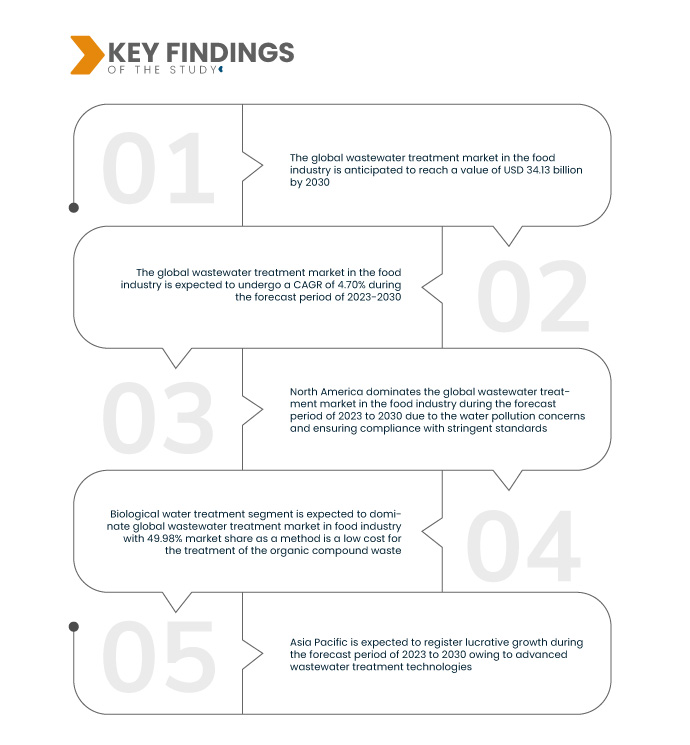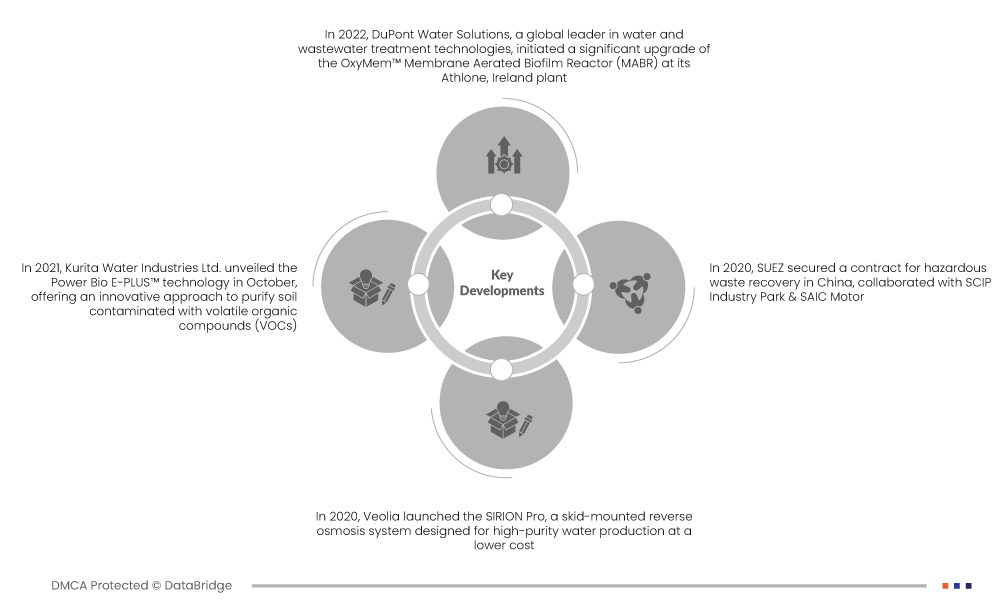Der globale Markt für Abwasserbehandlung in der Lebensmittelindustrie befasst sich mit Abwässern aus der Lebensmittelproduktion, die für die Einhaltung von Umweltvorschriften unerlässlich sind. Wasser, ein wichtiger Rohstoff in der Branche, wird zur Reinigung und Produktion verwendet, bevor es für die Wiederverwendung oder umweltverträgliche Entsorgung aufbereitet wird. Da die industrielle Nutzung 19 % des weltweiten Wasserverbrauchs ausmacht, spielt die Lebensmittel- und Getränkeindustrie eine bedeutende Rolle bei der Wassernutzung. Dies unterstreicht die Bedeutung eines effektiven Abwassermanagements zur Einhaltung strenger Umweltstandards.
Vollständigen Bericht abrufen unter https://www.databridgemarketresearch.com/reports/global-wastewater-treatment-market
Data Bridge Market Research analysiert, dass der globale Markt für Abwasserbehandlung in der Lebensmittelindustrie, der im Jahr 2022 23,64 Milliarden US-Dollar betrug, bis 2030 voraussichtlich 34,13 Milliarden US-Dollar erreichen und im Prognosezeitraum von 2023 bis 2030 eine durchschnittliche jährliche Wachstumsrate (CAGR) von 4,70 % aufweisen wird. Das öffentliche Bewusstsein für Umweltverschmutzung und Wasserqualität führt zu einem verantwortungsvollen Abwassermanagement in der Lebensmittelindustrie. Mit dem zunehmenden Umweltbewusstsein reagieren Unternehmen mit nachhaltigen Praktiken, um die Probleme zu lösen und zu saubereren Wasserökosystemen beizutragen.
Wichtigste Ergebnisse der Studie
Strenge Umweltvorschriften dürften das Marktwachstum ankurbeln
Das weltweit wachsende Umweltbewusstsein hat zu immer strengeren Vorschriften für die Abwasserbehandlung in der Lebensmittelindustrie geführt. Regierungen weltweit schreiben mittlerweile umfassende Abwasserbehandlungsverfahren vor, um die Umweltbelastung zu minimieren und die Einhaltung gesetzlicher Vorschriften zu gewährleisten. Dieser Wandel spiegelt das gemeinsame Engagement für nachhaltige Praktiken wider und veranlasst die Akteure der Lebensmittelindustrie, fortschrittliche Technologien und Verfahren einzusetzen, die nicht nur diese strengen Standards erfüllen, sondern auch zum allgemeinen Umweltschutz beitragen.
Berichtsumfang und Marktsegmentierung
Berichtsmetrik
|
Details
|
Prognosezeitraum
|
2023 bis 2030
|
Basisjahr
|
2022
|
Historische Jahre
|
2021 (Anpassbar auf 2015–2020)
|
Quantitative Einheiten
|
Umsatz in Milliarden USD, Mengen in Einheiten, Preise in USD
|
Abgedeckte Segmente
|
Typ (Physikalische Behandlungsmethoden, Biologische Wasserbehandlung, Wasserbehandlung in Chemieanlagen), Kategorie (Öl-/Wassertrennung, Entfernung suspendierter Feststoffe, Entfernung gelöster Feststoffe, Biologische Behandlung/Nährstoff- und Metallrückgewinnung, Desinfektion/Oxidation, Sonstiges), Technologie (Aktivkohlefilter, Chlorierung, Destillation, Elektrodeionisierung, Ionenaustausch, Mikrofiltration, Nanofiltration, Umkehrosmose, Ultrafiltration, Sonstiges), Anwendung (Fleischverarbeitung, Obst und Gemüse, Geflügel, Kartoffelverarbeitung, Süßwaren, Reisverarbeitung, Desserts, kalte Kuchen, Sonstiges)
|
Abgedeckte Länder
|
USA, Kanada, Mexiko, Brasilien, Argentinien, Restliches Südamerika, Deutschland, Frankreich, Italien, Großbritannien, Belgien, Spanien, Russland, Türkei, Niederlande, Schweiz, Restliches Europa, Japan, China, Indien, Südkorea, Australien, Singapur, Malaysia, Thailand, Indonesien, Philippinen, Restlicher Asien-Pazifik-Raum, Vereinigte Arabische Emirate, Saudi-Arabien, Ägypten, Südafrika, Israel und Restlicher Naher Osten und Afrika
|
Abgedeckte Marktteilnehmer
|
Suez (Frankreich), Veolia (Frankreich), Adroit Associates Private Limited (Indien), Sauber Environmental Solutions Pvt. Ltd. (Indien), SPEC INDIA (Indien), Xylem (USA), DuPont (USA), 3M (USA), Pentair (Großbritannien), United Utilities Group PLC (Großbritannien), Kingspan Group Plc (Großbritannien), Dow (USA), BASF SE (Deutschland), Kurita Water Industries Ltd. (Japan), Bio-Microbics, Inc. (USA), Calgon Carbon Corporation (USA), Trojan Technologies Inc. (Kanada), Kemira Oyj (Finnland), Thermax Limited (Indien), Wog Technologies (Indien), Golder Associates, Inc. (Kanada), SWA Water (Australien) und Burns & McDonnell (USA) unter anderem
|
Im Bericht behandelte Datenpunkte
|
Zusätzlich zu den Einblicken in Marktszenarien wie Marktwert, Wachstumsrate, Segmentierung, geografische Abdeckung und wichtige Akteure enthalten die von Data Bridge Market Research kuratierten Marktberichte auch ausführliche Expertenanalysen, geografisch dargestellte Produktion und Kapazität nach Unternehmen, Netzwerklayouts von Distributoren und Partnern, detaillierte und aktuelle Preistrendanalysen und Defizitanalysen der Lieferkette und Nachfrage.
|
Segmentanalyse:
Der globale Markt für Abwasserbehandlung in der Lebensmittelindustrie ist nach Typ, Kategorie, Technologie und Anwendung segmentiert.
- Der globale Markt für Abwasserbehandlung in der Lebensmittelindustrie ist nach Typ in physikalische Behandlungsverfahren, biologische Wasseraufbereitung und chemische Anlagenwasseraufbereitung unterteilt. Das Segment der biologischen Wasseraufbereitung wird voraussichtlich mit einem Marktanteil von 49,98 % den globalen Markt für Abwasserbehandlung in der Lebensmittelindustrie dominieren, da es sich um eine kostengünstige Methode zur Behandlung organischer Abfälle im Abwasser handelt, was die Nachfrage weltweit erhöht.
Das Segment der biologischen Wasseraufbereitung wird das Typsegment des Abwasseraufbereitungsmarktes im Lebensmittelindustriemarkt dominieren
Das Segment der biologischen Wasseraufbereitung wird sich mit einem Marktanteil von rund 49,98 % als dominierendes Segment herauskristallisieren. Dies ist auf die zunehmende Zahl von Infrastrukturentwicklungsaktivitäten im Markt, insbesondere in den Entwicklungsländern, zurückzuführen. Darüber hinaus wird das weltweite Wachstum und die Expansion der Chemie- und Werkstoffindustrie das Wachstum dieses Segments fördern.
- Der globale Markt für Abwasserbehandlung in der Lebensmittelindustrie ist nach Kategorien unterteilt in Öl-/Wassertrennung, Entfernung von Schwebstoffen, Entfernung von gelösten Feststoffen, biologische Behandlung/Nährstoff- und Metallrückgewinnung, Desinfektion/Oxidation und andere.
- Auf der Grundlage der Technologie ist der globale Markt für Abwasserbehandlung in der Lebensmittelindustrie in Aktivkohlefilter , Chlorierung, Destillation, Elektrodeionisierung, Ionenaustausch, Mikrofiltration, Nanofiltration, Umkehrosmose, Ultrafiltration und andere unterteilt.
- Der globale Markt für Abwasserbehandlung in der Lebensmittelindustrie ist nach Anwendungsgebieten in Fleischverarbeitung, Obst und Gemüse, Geflügel, Kartoffelverarbeitung, Süßwaren, Reisverarbeitung, Desserts, kalte Kuchen und weitere Bereiche unterteilt. Es wird erwartet, dass das Segment Fleischverarbeitung den globalen Markt für Abwasserbehandlung in der Lebensmittelindustrie mit einem Marktanteil von 29,93 % dominieren wird, da die Nachfrage nach Tiefkühlfleischprodukten und anderen Fleischprodukten steigt.
Hauptakteure
Data Bridge Market Research erkennt die folgenden Unternehmen als die wichtigsten Akteure auf dem globalen Markt für Abwasserbehandlung in der Lebensmittelindustrie an: SPEC INDIA (Indien), Xylem (USA), DuPont (USA), 3M (USA), Pentair (Großbritannien), United Utilities Group PLC (Großbritannien), Kingspan Group Plc (Großbritannien), Dow (USA), BASF SE (Deutschland), Kurita Water Industries Ltd. (Japan)
Marktentwicklungen
- Im Jahr 2022 begann DuPont Water Solutions, ein weltweit führendes Unternehmen für Wasser- und Abwasseraufbereitungstechnologien, mit einer umfassenden Modernisierung des OxyMem Membrane Aerated Biofilm Reactor (MABR) in seinem Werk in Athlone, Irland. Diese Investition in Infrastruktur und Personal trug dazu bei, die steigende weltweite Nachfrage nach MABR-Technologie zu decken und unterstreicht DuPonts Engagement für die Weiterentwicklung von Wasseraufbereitungslösungen.
- Im Oktober 2021 stellte Kurita Water Industries Ltd. die Power Bio E-PLU-Technologie vor, einen innovativen Ansatz zur Reinigung von mit flüchtigen organischen Verbindungen (VOCs) kontaminiertem Boden. Diese bahnbrechende Lösung macht Bodenaushub überflüssig und stellt einen entscheidenden Schritt zur Bekämpfung von Schadstoffen in Boden und Grundwasser dar. Sie unterstreicht Kuritas Engagement für eine nachhaltige Umweltsanierung.
- Im Jahr 2020 brachte Veolia den SIRION Pro auf den Markt, eine rahmenmontierte Umkehrosmoseanlage für die kostengünstige Produktion hochreiner Wasserqualität. Dieses Modell zeichnet sich durch einfache Wartung für Techniker und Endverbraucher aus und erweitert damit das Produktportfolio von Veolia. Die Innovation dürfte den Umsatz des Unternehmens in absehbarer Zukunft steigern.
- Im Jahr 2020 sicherte sich SUEZ einen Vertrag zur Entsorgung gefährlicher Abfälle in China und arbeitete dabei mit dem SCIP Industry Park und SAIC Motor zusammen. Diese strategische Zusammenarbeit befasst sich mit lokalen Umweltproblemen, trägt zur Entwicklung eines neuen Ökosystems für Umweltdienstleistungen bei und positioniert SUEZ für steigende Umsätze in den kommenden Jahren.
Regionale Analyse
Geografisch betrachtet sind die im Bericht zur Lebensmittelindustrie abgedeckten Länder des globalen Abwasserbehandlungsmarktes die USA, Kanada, Mexiko, Brasilien, Argentinien, das übrige Südamerika, Deutschland, Frankreich, Italien, Großbritannien, Belgien, Spanien, Russland, die Türkei, die Niederlande, die Schweiz, das übrige Europa, Japan, China, Indien, Südkorea, Australien, Singapur, Malaysia, Thailand, Indonesien, die Philippinen, der übrige asiatisch-pazifische Raum, die Vereinigten Arabischen Emirate, Saudi-Arabien, Ägypten, Südafrika, Israel sowie der übrige Nahe Osten und Afrika
Laut Marktforschungsanalyse von Data Bridge:
Nordamerika ist die dominierende Region auf dem globalen Abwasserbehandlungsmarkt in der Lebensmittelindustrie im Prognosezeitraum 2023-2030
Nordamerika dominiert den globalen Markt für Abwasserbehandlung in der Lebensmittelindustrie und verfügt über einen erheblichen Marktanteil und Umsatz. Diese Dominanz ist auf strenge Umweltvorschriften, technologische Fortschritte und einen proaktiven Ansatz für nachhaltige Praktiken zurückzuführen. Das Engagement der Region, Probleme der Wasserverschmutzung anzugehen und die Einhaltung strenger Standards sicherzustellen, positioniert sie als führendes Unternehmen in der Abwasserbehandlung. Es wird erwartet, dass sich dieser Trend fortsetzt und die Marktdominanz Nordamerikas im Prognosezeitraum von 2023 bis 2030 weiter stärkt.
Der asiatisch-pazifische Raum wird im Prognosezeitraum 2023–2030 voraussichtlich die am schnellsten wachsende Region auf dem globalen Markt für Abwasserbehandlung in der Lebensmittelindustrie sein.
Es wird erwartet, dass der asiatisch-pazifische Raum von 2023 bis 2030 den globalen Markt für Abwasserbehandlung in der Lebensmittelindustrie dominieren wird. Dieses Wachstum wird durch die rasante Industrialisierung, das Bevölkerungswachstum und die zunehmende Urbanisierung in der Region vorangetrieben. Der Fokus der Regierung auf ökologische Nachhaltigkeit und strenge Vorschriften fördern die Einführung fortschrittlicher Abwasserbehandlungstechnologien. Darüber hinaus steigern das gestiegene Bewusstsein für Wasserknappheit und den Bedarf an sauberem Wasser die Nachfrage nach effizienten Abwassermanagementlösungen weiter und machen den asiatisch-pazifischen Markt besonders lukrativ.
Für detailliertere Informationen zum globalen Markt für Abwasserbehandlung im Bericht der Lebensmittelindustrie klicken Sie hier – https://www.databridgemarketresearch.com/reports/global-wastewater-treatment-market












